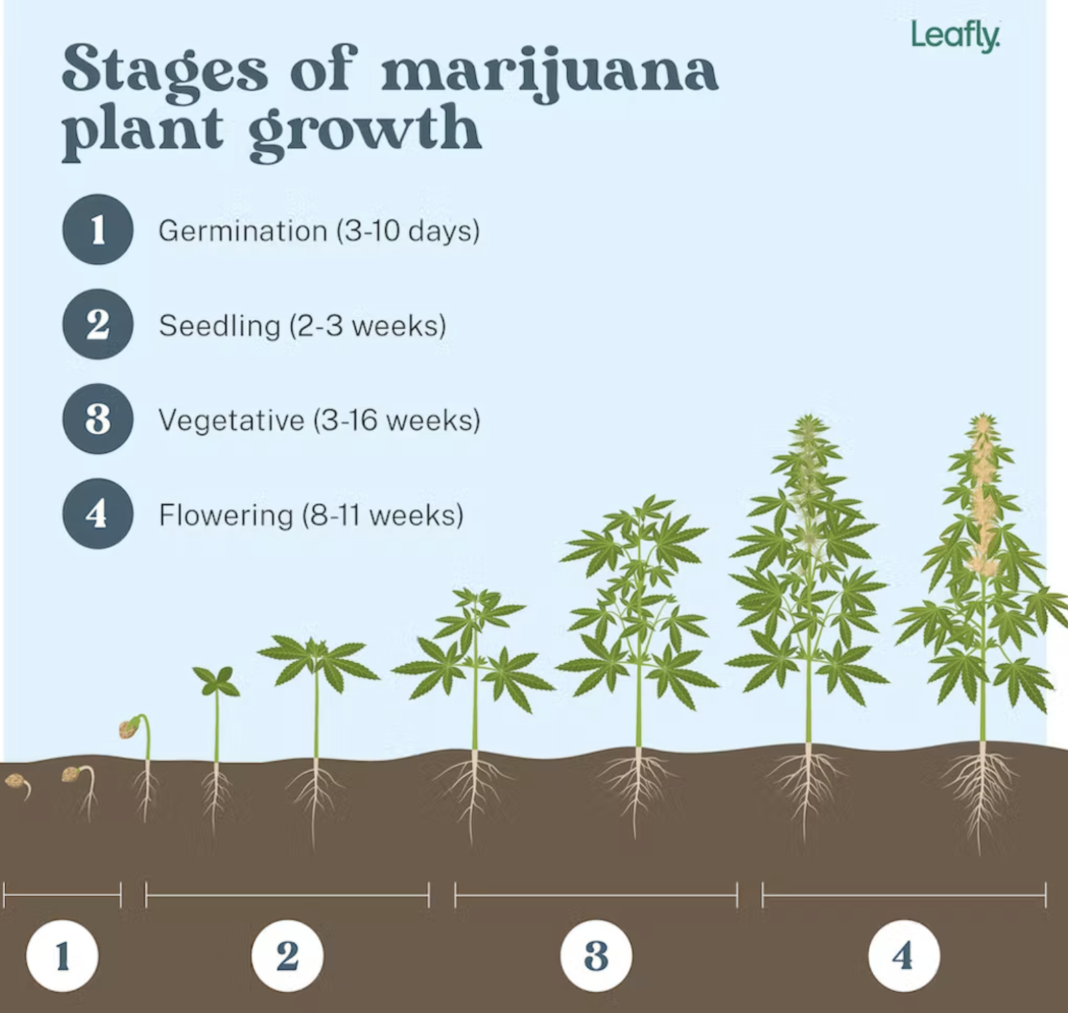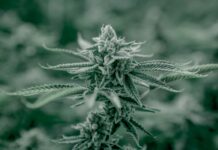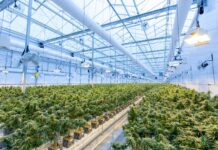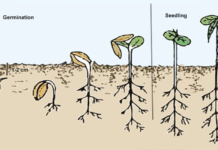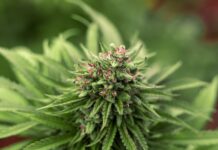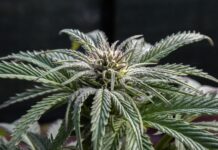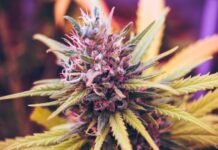Table of Contents :
Four stage life cycle
It takes from 4 to 8 months to grow a cannabis plant, depending on:
- Whether you grow indoors or outdoors. If you grow outdoors, the growing season depends on where in the world you grow.
- The strain of cannabis you are growing
There are 4 stages in the life cycle of a cannabis plant:
- Germination (3-10 days): When the seed sprouts and pops out of the soil
- Seedling (2-3 weeks): After germination, when the plant develops its first cotyledon leaves
- Vegetative (3-16 weeks): The immature or juvenile stage, when a cannabis plant grows its stalks, branches, stems, and fan leaves
- Flowering (8-11 weeks): When a weed plant starts producing buds
Seed
To start the life of a cannabis plant, you need a cannabis seed that you sow in soil or another suitable growing medium. There are many different cannabis seeds to choose from, each with its own characteristics.
Read more: Cannabis seed guide
Germination (3-10 days)
The seed lies dormant until it is exposed to warmth and moisture. For germinating, Cannabis seeds need warm temperature, humidity, air, and water. Place them in a dark, warm, and humid place, for example between two plates in a damped napkin.
When the seed opens up and starts showing the first white tap root, it’s time to put it in its next growing medium (soil, coco, etc) in a small pot with drainage. This root will immediately begin to develop and grow downwards, while the stem will grow upwards.
When the stem reaches sunlight, the plant will begin to produce its first two oval leaves from the seed’s protected sheath. These two leaves are called cotyledons, and tell that the seed is now a seedling! These first leaves are responsible for taking in sunlight so that the plant can grow healthy and stable.
The ideal conditions after you have put the germinated seed in the soil until the seed becomes a seedling are:
Lightning
Place a fluorescent grow light about two inches from the top of your medium for 18 hours per day. You don’t need a strong light for them in the beginning.
Humidity
Keep your seeds in a wet humidity at around 65 – 80%.
Water
Keep the soil wet, but water your seeds with a sprayer to avoid overwatering.
Nutrition/fertilizer
There is enough nutrition in a seed to feed a sprout for about two to three weeks. It is therefore not necessary to fertilize the plant at this stage.
Read more: Germination of cannabis seed
Seedling (2-3 weeks)
Leafly describes this stage as follows:
“When your marijuana plant becomes a seedling, you’ll notice it developing the traditional cannabis fan leaves. As a sprout, the seed will initially produce leaves with only one ridged blade.
Once new growth develops, the leaves will develop more blades, or “fingers” (3, 5, 7, etc.). A mature cannabis plant will have between 5 or 7 blades per leaf, but some plants may have more.
Cannabis plants are considered seedlings until they begin to develop leaves with the full number of blades on new fan leaves. A healthy seedling should be a vibrant green color”.
At this stage, the plant is vulnerable to disease, pest and mold, so this is a good time to apply a preventative neem oil treatment. It’s much easier to prevent spider mites and powdery mildew than to treat them. If they do get infested at this age, the stress on your plants will likely produce a smaller harvest.
Keep its environment clean and monitor excess moisture.
Lightning
18 hours per day (8 hours darkness) with plenty white grow light.
Humidity
Keep your seedlings in a wet humidity at around 65 – 80%.
Water
Be careful to not overwater. The plant in its seedling stage—its roots are so small, it doesn’t need much water to thrive. Water your seedlings with a sprayer to avoid overwatering.
Nutrition/fertilizer
Since the seed contains all the nutrients the plant needs for the first 2-3 weeks of the plant’s life, you do not need to fertilize until the end of the seeding period. Start with a low dose of nutrients, before gradually increasing as the plant transitions to its vegetative stage.
Vegetative (3-16 weeks)
After a few weeks as seedlings, your cannabis plants will outgrow their starter pots and begin to require more food and light. The roots and leaves now start to grow very quickly, so that the plant can absorb more nutrients and carbon dioxide. Don’t be surprised if your plant shoots up two inches in one day! The vegetative stage normally lasts between 3-16 weeks (depending on the strain and conditions).
We are now starting to top the plants to get them healthy and we need to increase watering considerably. Vegetative plants appreciate healthy soil with nutrients.
It is also now possible to identify whether the plant is a female or male plant. Identifying the sex of the plant is important in order to remove all male plants that do not produce THC. About four weeks into the growing season, pre-flowering will begin to appear. Within six weeks you should be able to tell if the new buds are male or female.
Lightning
You control the length of this phase by the number of hours of light you give your plants. As long as they get 18 hours daylight and 8 hours darkness, they will remain in this stage. Give the plant plenty white grow light.
Humidity
Relative humidity should be at around 40 – 60%.
Water
The plant need plenty with water. Water the plant every 2-3 days, depend on the condition the plant grow in.
Nutrition/fertilizer
The plant need a high level of nitrogen and modest amounts of phosphorus and potassium. Silicon is also beneficial at this stage because it helps to build strength in the stalk and stems, which you’ll need to support those big buds that will soon grow.
Flowering (8-11 weeks)
The flowering stage is the last stage of growth for a cannabis plant. This is when plants begin to develop resinous buds and your hard work will come to fruition. Most strains flower in 8-9 weeks, but some can take even longer, especially some sativas.
To enter the flowering stage in indoor crops, the photoperiod must be changed to a 12 hour light / 12 hour dark schedule. If you grow outdoors, the plant will start to bloom when the days get shorter and the nights longer, normally in autumn.
Autoflowering strains do not need a photoperiod change to start flowering, their vegetative stage lasts around 4 weeks and then it automatically switches to flowering.
It is extremely important NOT to INTERRUPT the hours of darkness (lights off) for the plant to start blooming properly. If this dark period is interrupted, the plant becomes “confused” and flowering may be delayed or worse, the plant may revegetate (return to the vegetative stage) or start producing hermaphrodite flowers. You definitely don’t want that to happen!
There are three sub-phases of the flowering stage:
- Flower initiation (weeks 1-3): The plant will continue to grow and the females will develop pre-flowers – pistils, or white hairs, will grow out, which are the beginnings of buds.
- In the middle of flowering (weeks 4-5): The plant itself will stop growing and buds will begin to fatten up.
- Late flowering/ripening (week 6 onwards): Trichome density will increase and plants will become very sticky; keep an eye on the color of the pistils to tell when to harvest.
Buds usually grow most towards the end of the flowering life cycle. You probably won’t notice much budding at the beginning of the flowering stage, and it will slow down towards the end of the cycle, when buds finish.
Once buds have reached full maturity, it’s time to harvest your marijuana. How long it takes to harvest buds depends on many factors, including harvesting methods and how many plants you are harvesting.
When your buds grow large and dense, environmental conditions and poor air flow can create bud rot. If you do not detect the rot in time, you can lose all your plants. Therefore, keep an eye on the buds as harvest time approaches. Inspect the buds often and harvest immediately if you see signs of rot. If you catch it early, you can cut the rot out of the buds and save most of the crop.
You know the plant is ready to harvest when the pistils, or hairs, change the color of rust and the resin changes from clear to milky white.
Lightning
12 hours daylight and 12 hours darkness. Higher light intensity, red spectrum preferred
Humidity
Relative humidity should be at around 40 – 60%.
Water
The plant need plenty with water. Water the plant every 2-3 days, depend on the condition the plant grow in.
Nutrition/fertilizer
Your fertilization schedule must now be changed. Start feeding your plants with minimal amounts of nitrogen, moderate amounts of potassium, and high amounts of phosphorus. Add bloom enhancers and sugar to food.
Be on the lookout for nutrient deficiencies or toxicity. Brown leaf tips can signal nutrient burning, while yellowing leaves can indicate nutrient deficiency. However, it is normal for the lower leaves to turn yellow towards the end of the flowering cycle.
Continue to feed your plants until about 10 days before harvest, then stop fertilizing and rinse the crop. This cleans your plants of excess nutrients and is essential to ensure your end product is smooth rather than hard.
It is important to learn to understand the life cycle of the cannabis plant, as this enables you to properly care for your plant and predict problems before they occur.

